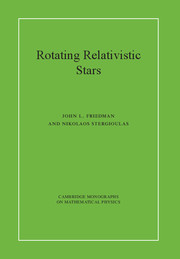Book contents
- Frontmatter
- Dedication
- Contents
- Preface
- List of symbols
- Conventions, notation, and mathematical preliminaries
- 1 Stationary, axisymmetric equilibria
- 2 3+1 split, action, Lagrangian, and Hamiltonian formalisms
- 3 Asymptotics, virial identities, and nonaxisymmetric equilibria
- 4 Numerical schemes
- 5 Equilibrium models
- 6 Approximation methods for equilibria
- 7 Perturbation theory of relativistic fluids
- 8 Quasinormal modes
- 9 Stellar stability
- 10 Nonlinear dynamics of rotating relativistic stars
- Appendix A Lie derivatives, forms, densities, and integration
- Appendix B The Newtonian limit of the two-potential formalism
- Bibliography
- Index
Appendix B - The Newtonian limit of the two-potential formalism
Published online by Cambridge University Press: 05 July 2013
- Frontmatter
- Dedication
- Contents
- Preface
- List of symbols
- Conventions, notation, and mathematical preliminaries
- 1 Stationary, axisymmetric equilibria
- 2 3+1 split, action, Lagrangian, and Hamiltonian formalisms
- 3 Asymptotics, virial identities, and nonaxisymmetric equilibria
- 4 Numerical schemes
- 5 Equilibrium models
- 6 Approximation methods for equilibria
- 7 Perturbation theory of relativistic fluids
- 8 Quasinormal modes
- 9 Stellar stability
- 10 Nonlinear dynamics of rotating relativistic stars
- Appendix A Lie derivatives, forms, densities, and integration
- Appendix B The Newtonian limit of the two-potential formalism
- Bibliography
- Index
Summary
Introduction
Because of its importance for astrophysics in a variety of contexts, the problem of the oscillations of rotating Newtonian stellar models has received considerable attention. Even so, up until very recently all attempts to obtain solutions to the equations governing the oscillations of rotating models had been unsuccessful. The lone exception is Clement's [145] analysis of certain axisymmetric normal modes.
In large part, the reason why the Newtonian oscillation problem has posed such difficulty is that the eigenequations for normal-mode pulsations are traditionally written down in terms of the Lagrangian displacement vector ξα. This leads to a complicated eighth-order system of equations for four dependent variables. This system has proved intractable for generally nonaxisymmetric modes. Although it has been used to develop variational principles (e.g., Lynden-Bell and Ostriker [450], Friedman and Schutz [241, 242]) for estimating normal-mode eigenfrequencies, it has yielded little information concerning the eigenfunctions themselves. And in a variety of contexts, detailed knowledge of the eigenfunctions is needed. For example, knowledge of the normal-mode eigenfunctions, in addition to the eigenfrequencies, is required for accurate assessment of the combined effects of gravitational radiation reaction and of viscous dissipation on the evolution and stability of millisecond pulsars, and for understanding the interaction between a pulsating star and a surrounding accretion disk.
- Type
- Chapter
- Information
- Rotating Relativistic Stars , pp. 369 - 374Publisher: Cambridge University PressPrint publication year: 2013



